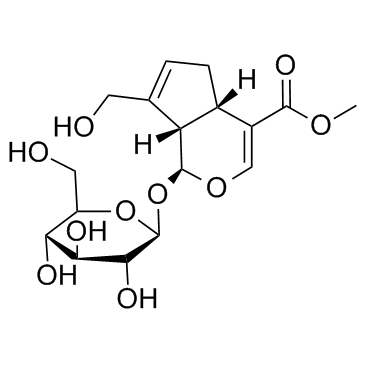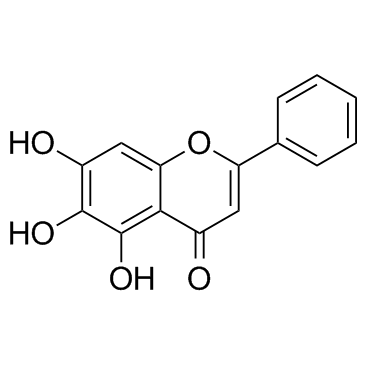The different inhibitory effects of Huang-Lian-Jie-Du-Tang on cyclooxygenase 2 and 5-lipoxygenase.
Li Li, Huawu Zeng, Lei Shan, Xin Yuan, Yushan Li, Runhui Liu, Weidong Zhang
Index: J. Ethnopharmacol. 143(2) , 732-9, (2012)
Full Text: HTML
Abstract
Huang-Lian-Jie-Du-Tang (HLJDT), a famous traditional Chinese prescription with wide anti-inflammatory applications, is an aqueous extract of four herbal materials: Rhizoma coptidis, Radix scutellariae, Cortex phellodendri, and Fructus gardeniae. Its effects on the cyclooxygenase (COX)-2 and 5-lipoxygenase (5-LOX) pathways are thought to be responsible for its anti-inflammatory activity. However, our previous work found that the inhibitory effects of HLJDT act on the 5-LOX pathway but not on the COX pathway. The possibility that HLJDT inhibits COX-2- or 5-LOX-catalyzed eicosanoid generation by downregulating enzyme expression requires further investigation.To observe the effects of HLJDT and its four major components (baicalin, baicalein, berberine and geniposide) on COX-2- or 5-LOX-catalyzed eicosanoid generation and to distinguish the effects of HLJDT on enzyme activity from those on enzyme expression.The topical anti-inflammatory activities and inhibition of eicosanoid formation of HLJDT and its components were observed in an arachidonic acid (AA)-induced mouse ear edema model. Macrophage-based systems were established to observe the effects of the drugs on enzyme activity and enzyme expression of COX-2 and 5-LOX. Further experiments were carried out to confirm these effects at the mRNA and protein levels.Topical treatment of HLJDT significantly inhibited AA-induced mouse ear edema and reduced PGE(2) and LTB(4) release in the edematous ears. Baicalein, geniposide, and berberine also ameliorated the symptoms and suppressed eicosanoid generation with varying efficacies. Cell-based assays showed that HLJDT and baicalein inhibited the PGE(2) levels by decreasing COX-2 enzyme expression without affecting COX-2 enzyme activity in RAW 246.7 murine macrophages. The other experiments on rat peritoneal macrophages indicated that HLJDT and baicalein exerted significant inhibition on LTB(4) production by decreasing 5-LOX enzyme activity. The real-time PCR and western blotting data demonstrated that HLJDT and baicalein reduced COX-2 expression at the mRNA and protein levels, whereas no inhibition on 5-LOX expression was observed.HLJDT can suppress eicosanoid generation via both the COX and LOX pathways, which definitely contributes to its topical anti-inflammatory activity. We have confirmed that its dual inhibition on the COX and LOX pathways mainly result from the downregulation of COX-2 expression and direct inhibition of 5-LOX activity, respectively. Baicalein worked as a potent active component in most of the tests. These findings about the different inhibitory effects of HLJDT on COX-2 and 5-LOX help to better understand the mechanism of HLJDT and promote safer applications of drug.Copyright © 2012 Elsevier Ireland Ltd. All rights reserved.
Related Compounds
| Structure | Name/CAS No. | Molecular Formula | Articles |
|---|---|---|---|
 |
Geniposide
CAS:24512-63-8 |
C17H24O10 | |
 |
Baicalein
CAS:491-67-8 |
C15H10O5 |
|
The effects of notoginsenoside R₁ on the intestinal absorpti...
2012-06-26 [J. Ethnopharmacol. 142(1) , 136-43, (2012)] |
|
[Effects of geniposide on SNP-induced apoptosis of chondrocy...
2013-03-01 [Zhongguo Gu Shang 26(3) , 232-5, (2013)] |
|
Pharmacokinetics of geniposide by monoclonal antibody-based ...
2014-01-01 [Biol. Pharm. Bull. 37(9) , 1525-33, (2014)] |
|
Natural borneol enhances geniposide ophthalmic absorption in...
2013-03-10 [Int. J. Pharm. 445(1-2) , 163-70, (2013)] |
|
Enrichment and purification of gardenia yellow from Gardenia...
2012-04-15 [J. Chromatogr. B. Analyt. Technol. Biomed. Life Sci. 893-894 , 43-8, (2012)] |